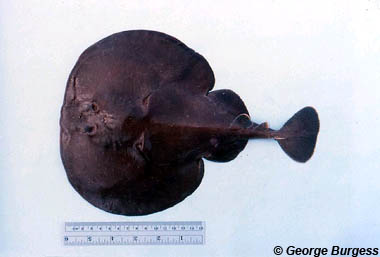
Tetronarce nobiliana
This large ray has an oval pectoral disc, two lobed dorsal fins on its stout tail, and a large caudal (tail) fin, all dark gray-brown on top and light underneath. Kidney-shaped electric organs on either side of its head are barely visible in the pectoral fins, but can deliver a stunning shock to humans or kill small fish.
This migratory ray prefers soft bottoms or coral reefs where it can ambush prey and grow to over 70 inches long.
Order – Torpediniformes
Family – Torpedinidae
Genus – Tetronarce
Species – nobiliana
Common Names
English language common names include Atlantic torpedo, Atlantic electric ray, Atlantic New British torpedo, black torpedo, crampfish, dark electric ray, electric ray, electricfish, great torpedo, numbfish, and torpedo. Other common names are anko-shibire-ei (Japanese), arrrai (Portuguese), Atlantický rejnok elektrický (Czech), Atlantiese drilvis (Afrikaans), darrocka (Swedish), dretwa brunatna (Polish), Dunkler Zitterrochen (German), elektrik baligi (Turkish), esturpillo (Spanish), haddiela mdahhna (Maltese), haddiela samra (Maltese), haddiela sewda (Maltese), mavromoudiastra (Greek), peste torpila (Rumanian), piskë (Albanian), raia (Portuguese), schwarzer Zitterrochen (German), sgranfo (Italian), sidderrog (Dutch), silmäsähkörausku (Finnish), sort elektrisk rokke (Danish), sort elrokke (Danish), sysisähkörausku (Finish), temblador de mar (Spansih), temblaera (Spanish), torpedine nera (Italian), torpedo de lo alto (Spanish), torpedo del Atlántico (Spanish), torpille (French), torpille noire (French), torpille noire stupéfiante (French), tremblador negro (Spanish), tremelga (Portuguese), tremelga negra (Spanish), tremolo grando (Italian), tremula ‘mpiriale (Italian), tremula nira (Italian), trimielga negra (Spanish), uyusturan balik (Turkish), vaca negra (Catalan), vaca negrosa (Catalan), vaca temblaera (Spanish), zitterrochen (German), and zwarte sidderrog (Dutch).
Importance to Humans
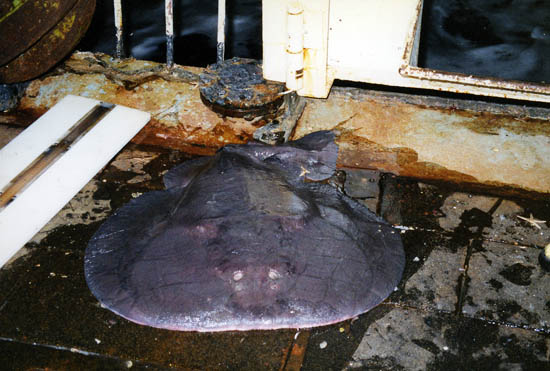
In years past, this ray was valued for its liver oil considered of high quality for illumination purposes prior to the use of kerosene oil. It is currently of no commercial value or interest to fisheries, drawing only curiosity due to its ability to produce electrical charges. In Roman and Greek ancient times, the electrical shock of the Atlantic torpedo was used to treat gout, headache, and other maladies.
Danger to Humans
A large adult Atlantic torpedo can deliver a painful and stunning electric charge strong enough to disable a person. The primary threat to life is becoming disoriented underwater after receiving the jolt ranging from 170-220 volts. However, it is extremely unlikely that the electric charge could lead to cardiac arrest or ventricular fibrillation in humans.
Conservation
> Check the status of the Atlantic torpedo at the IUCN website.
The IUCN is a global union of states, governmental agencies, and non-governmental organizations in a partnership that assesses the conservation status of species.
Geographical Distribution
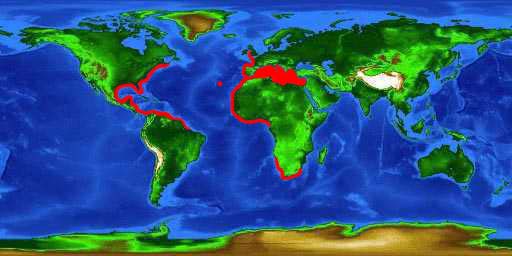
As suggested by its common name, the Atlantic torpedo is found in the Atlantic Ocean. In the western Atlantic, it is distributed from Nova Scotia, Canada south to Brazil. The range of this torpedo in the eastern Atlantic region is from Scotland south to Morocco including the Mediterranean Sea but absent in the Black Sea. It also lives from Cap Blanc in Mauritania to the Gulf of Guinea, São Tomé Island, Walvis Bay, and Namibia to Mossel Bay in South Africa.
Habitat
Adults are semi-pelagic to pelagic living in the water column at 7-2,625 feet (2-800 m) depths. Juveniles are benthic and live over soft bottom and coral reef habitats. This species reportedly migrates over long distances.
Biology
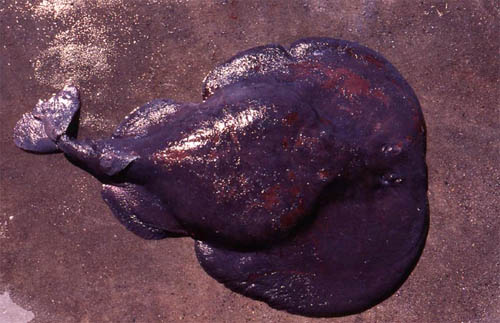
Distinctive Features
The Atlantic torpedo is a large ray with a large paddle-shaped caudal fin. The sub-circular disc is broad and truncate along the front. The eyes are small and set relatively far apart. The short snout is located anterior to the eyes. Both dorsal fins are located on the tail. The first dorsal fin is distinctly larger than the second dorsal fin. The spiracles have smooth margins with no tentacles or papillae. The electric organs are located on the pectoral fins to either side of the head, giving the skin a honeycomb-like appearance.
Similar species include the marbled electric ray (Torpedo marmorata) however it can be easily distinguished by its marbled coloration and the papillae present along the inner edge of the spiracles.
Another species confused with the Atlantic torpedo is the lesser electric ray (Narcine bancrofti). However, the Atlantic torpedo can be distinguished from the lesser electric ray by its almost straight anterior margin of the disc, the large caudal fin, the short snout, and the lack of blotches on the dorsal surface of the body.
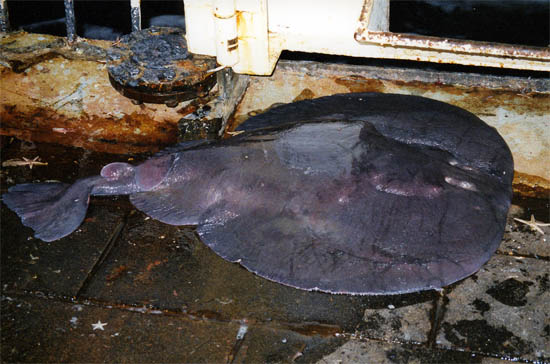
Coloration
The dorsal surface of the Atlantic torpedo is dark gray to dark brown, sometimes appearing black. White spots and darker dots may be present on the dorsal surface of this ray. The ventral surface is white or cream-colored often with dusky margins around the disc and pelvic fins.
Dentition
The dentition consists of small curved single-cusped teeth arranged in about bands with approximately 7 rows exposed. These teeth form a pavement-like surface in both jaws.
Denticles
The skin of the Atlantic torpedo is soft and smooth with no thorns or tubercles present.
Size, Age, and Growth
The maximum reported size of the Atlantic torpedo is 70.9 inches (180 cm) total length with a maximum published weight of 198 pounds (90.0 kg). Specimens are usually 2-5 feet (0.6-1.5 m) in length and seem heavy for their size.
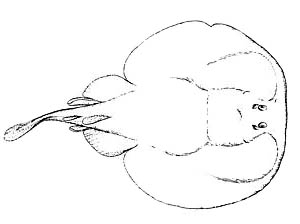
Food Habits
The Atlantic torpedo feeds primarily on large benthic and pelagic fish including sharks, dogfish, flounder, and mullet. It catches and envelops fish with its pectoral fins, delivering a powerful electric shock of 170-220 volts from the electric organs. These electric organs are located in the pectoral fins and produce a charge that will stun or kill a fish before the torpedo eats it.
This ray can distend its jaws allowing it to swallow fishes larger than thought possible based on the width of the mouth when closed.
Reproduction
The reproductive mode of this ray is ovoviviparous with embryos feeding initially on yolk, then receiving additional nourishment from the mother by indirect absorption of uterine “milk” that is enriched with mucus, fat and protein.
Although there is little known about the reproduction of the Atlantic torpedo, it is thought that the gestation period is approximately a year in length. Each female releases up to 60 young at what is believe to be an offshore location. The young are about 8 inches (20 cm) in length at birth.
Predators
This ray has few natural predators due to its formidable electric capabilities and large size. Predators such as sharks and other large carnivorous fishes seldom confront electric rays.
Parasites
Parasites of the Atlantic torpedo include the monogenean Amphibdella flavolineata. The juvenile stages live in the blood of this ray while the adult stage lives in the gills.
Taxonomy
The Atlantic torpedo was originally described as Torpedo nobiliana by Bonaparte (1835). Its genus name, Torpedo, comes from the Latin word ‘torpidus’ meaning numbness in reference to the effect of the electric organ. Other combinations such as Tetronarce nobiliana, Narcacion nobiliana, and Narcobatus nobiliana are considered invalid. Synonyms appearing in past scientific literature include Torpedo hebetans Lowe 1838, Torpedo emarginata M’Coy 1841, Torpedo occidentalisStorer 1843, Torpedo nigra Guichenot 1850, and Torpedo walshii Thompson 1856.
Prepared by: Cathleen Bester